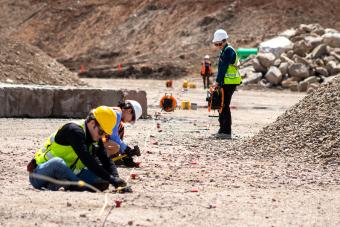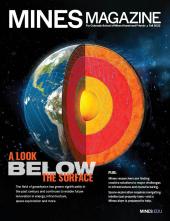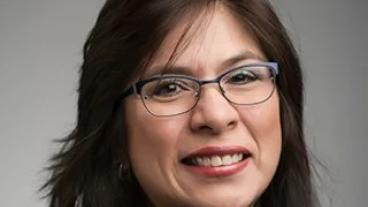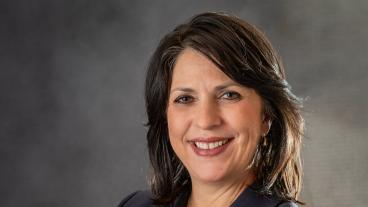For the future of geophysics, not even the sky is the limit

Mines students set up a hammer seismic survey during the 2022 Geophysics Field Session in Steamboat Springs, Colorado. (Photo by Agata Bogucka/Colorado School of Mines.)
By Sarah Kuta, Special to Mines Magazine

As a child, Whitney Schultz ’17, MS ’19 remembers always being fascinated by rocks, a passion her geologist mother encouraged whenever they went on hikes or other outdoor adventures near their home in Parker, Colorado.
“I would collect pieces of muscovite and biotite, and my mom would point out different minerals in rocks I picked up,” said Schultz.
As she got older and began immersing herself in science and math, she never let go of that early love of geology, but she realized there was more going on beneath the Earth’s surface than meets the eye. And when she got to Mines and learned she could investigate and measure those subsurface conditions, Schultz was hooked. Geophysics became her clear path forward.
Today, she works as a geophysicist for the Houston-based energy company Oxy, interpreting seismic data in hopes of finding hydrocarbon deep underground.
“I can see geology and data from around the world, all in one place,” said Schultz. “When you really think about the scale and the time it took to form them, it’s just fascinating. It’s very humbling, to say the least. We’re talking about geologic time—millions of years.”
She’s one of the many skilled Mines graduates working in this small but in-demand field, which is expected to grow by 7 percent by 2030.
And while many up-and-coming geophysicists will continue to do the vitally important job of supplying the world with energy and minerals, others will put their expertise into practice in an array of diverse roles, from finding new sources of water to monitoring climate and critical infrastructure and even exploring other planets in the solar system.
For the future of geophysics, not even the sky is the limit.
“Students care about exploring our world and making a contribution—they care about the environment, they’re curious about the oceans, they have ambitions to go out into space,” said Paul Sava, who leads Mines’ geophysics department. “At Mines, we want to focus on things that have societal importance, and the field of geophysics is directly relevant to a whole spectrum of applications that have meaning to many people all over the world.”
Geophysics: Past and Present
In 1926, Mines became the first university in the world to launch a standalone geophysics department when a group of academics got together to pursue novel methods for finding underground natural resources. The Society of Economic Geophysicists, now the Society of Exploration Geophysicists, formed not long after in 1930.
“The original thinking was that the field of geophysics would evolve in its own direction because it was intrinsically linked with emerging technologies,” said Sava of Mines’ pioneering geophysics researchers. “The main distinction between geology and geophysics is that, in geophysics, we do not interact directly with the object of study, be that the Earth or some other planetary body. Instead, we take measurements from the outside of this object of different physical fields, and then through math and computing, we create an image of that interior structure, just like in medical imaging.”
At that time, geophysicists were developing and using new cutting-edge techniques for exploring subsurface natural resources. As the field advanced throughout the 20th century, geophysicists continued to partner with the oil and gas industry to ensure the world had access to power and fuel, as well as the mineral resources needed to advance our technological society. To this day, many Mines geophysics graduates go on to work for energy and minerals companies.
“We are providing a necessary resource,” said Mandy Schindler PhD ’18, who works as an exploration geophysicist for Shell. “The demand for energy is still rising with the growing world population. We all know we need to move away from fossil fuels in the long run, but that’s going to be a gradual process—we’re still very much dependent on them. And it’s a resource that’s needed to make sure people can have the standard of living they deserve.”
In more recent years, the field has expanded to include a vast array of other applications, some of them surprising. Geophysical techniques can help predict and quantify natural hazards, including tsunamis, earthquakes, landslides and volcanic eruptions. Researchers in the field are also using geophysics to study glaciers, oceans and the atmosphere to draw inferences about the evolving Earth climate, as well as explore planetary bodies such as moons, asteroids, comets and other planets.
And as the global population continues to increase, geophysicists are also being called upon to search for and monitor groundwater, an application that’s likely to become crucial in the future.
“We are already witnessing dramatic changes in water distribution—we see it here in the West, and it’s having an enormous impact,” said Sava. “We see humongous lakes that are shrinking dramatically. And that poses the question of, well, how do we access water? Where’s the water, and, if it’s underground, how much is there? Can we access it, and how?”
Above all else, geophysical techniques help solve problems.
“Ultimately, planet Earth is our home,” said Sava. “The greatest technology and the greatest engineering don’t actually mean a whole lot if we can’t breathe, we can’t eat, we can’t drink and we don’t have a harmonious relationship with our home. That’s why understanding our home is something that should be of concern to all of us. Geophysicists are the people who keep their finger on the pulse of the planet, but this is of relevance to all of us.”
Technological advances lead the way
Novel applications aside, technological advancements are also moving the field forward in new ways. Researchers are now realizing that fiber optic cables—installed underground to bring high-speed internet to homes and businesses across the globe—can also gather geophysical data nearly continuously. Satellites, too, may be able to provide a constant stream of information about the Earth while orbiting the planet.
Sava compares these types of technological advancements to smartwatches: Whenever a person is wearing one, the device is monitoring and recording various aspects of the body’s functions for long periods of time, often without the wearer even noticing.
“We’ll have many more sensors that are active for much longer—we are not going to go to a place, take measurements and leave,” he said. “We’ll instrument the space of interest and monitor it permanently. We can continuously listen to the planet in meaningful ways.”
As an earth scientist for Chevron, Ivan Lim Chen Ning PhD ’19 is one of the pioneering professionals putting these new technologies into practice. He uses fiber optic cables, via a technique known as distributed acoustic sensing, to help the company’s engineers keep tabs on important metrics such as the structural integrity and flow rates of oil wells.
Outside of the energy sector, Lim said, researchers are also now using underwater fiber optic cables to detect earthquakes and tsunamis, which could help improve warning systems around the globe. Scientists are even using it to eavesdrop on whales, which lets them learn more about the massive marine mammals’ behavior.
“Just when we think we’re already getting the most out of it, there’s always a new application that spins out of the data we acquire,” he said. “It’s a rapidly evolving field.”
Looking ahead
As the field grows and evolves, Mines continues to be a leader in geophysics innovation, especially when it comes to educating the next generation of professionals who can help society overcome its challenges.
At Mines, professors and instructors teach students the fundamental skills of geophysics—including a deep understanding of math, physics, computing, geology and engineering—then encourage them to pursue rewarding career paths in a variety of areas.
The overarching philosophy is to build a strong technical foundation, then keep an open mind about applications.
These days, geophysicists can use their expertise to monitor the world’s changing ice sheets and glaciers, help archaeologists unearth historical structures, monitor evolving urban environments and even ensure that materials used to build airplane wings are free from defects, for example. Geophysicists also support homeland security and national defense efforts by detecting landmines and illegal underground structures. They can ensure that dams are structurally sound and study the potentially devastating effects of solar flares on the power grid. Geophysicists even go work for NASA, which sent a seismometer onboard the InSight lander to measure the internal activity and “marsquakes” of the Red Planet.
“I like that the field can tell us so much about our planet and other celestial bodies without damaging anything,” said Bryce Swinford ’07, who works as a senior geophysicist for Oxy. “And all our techniques are scalable: The same principles that let us look at things on a planetary scale can be used on something the size of a bowling ball or a human skull. Geophysical techniques are applicable to just about any scientific question we have that involves using physics to get insight into the interior of the object of study.”
Geophysicists will undoubtedly help with the energy transition, too, such as by identifying appropriate off-shore locations for windmills or searching for promising new stores of lithium and other minerals needed to create more batteries for electric vehicles and other devices. They’ll also help communities tap more into new sources of sustainable energy, such as the geothermal heat produced deep in the Earth’s core.
Already, they’re helping leading oil and gas companies figure out how to capture and sequester carbon dioxide, which accounts for 79 percent of the nation’s greenhouse gas emissions from human activities. Geophysicists can employ some of the same techniques used to find oil and gas to explore potential underground reservoirs for CO2 storage, which may help remove some of the heat-trapping gas from the atmosphere.
The possibilities for this field are seemingly endless, and according to Schindler, “We will find our place as geophysicists.”




